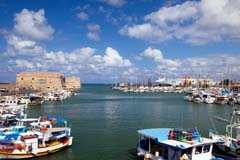You need to upgrade your Flash Player
Please visit Adobe's Flash Player site to upgrade the most recent version.
Thank you.
If you are having issues with installing Adobe Flash Player, please make sure that all "pop-up killer" applications are turned off and you reinstall
the Adobe player.
Heraklion, Crete
Heraklion sightseing

For sightseeing, among its main sites are the well preserved walls of the Venetian period. Much of the town's atmosphere is given by the central square - Platia Venizelou - in which stands the Morosini Fountain, the emblem of Heraklio a favourite meeting point and landmark.
 You should not omit to visit the Archaeological Museum at Platia Eleftherias (Freedom square), which is linked to Platia Venizelou by a pedestrian street (Venizelos was a revered elder statesman and prime minister of Greece, much of Greece’s hereditary territory was regained due to him).
You should not omit to visit the Archaeological Museum at Platia Eleftherias (Freedom square), which is linked to Platia Venizelou by a pedestrian street (Venizelos was a revered elder statesman and prime minister of Greece, much of Greece’s hereditary territory was regained due to him). The site of the palace of Knossos is located 5 km south-east of Heraklio and is a site every visitor to Crete should go to especially because of its easy access and proximity to Heralkio. It was excavated and restored by the archaeologist Arthur Evans a task that took over 40 years before the whole of what is left of the palace to come to light. This is where the very first plumbing system of antiquity in the form of conical earthenware tubes laid end to end and sealed at the joints was found. This palace is perhaps the most representative of the Cretan civilization along with its sister palace in Phaestos.
The entire palatial complex was quite large and consisted of approximately 1.400 rooms. Between 2.000 and 1.450 B.C. it was the ruling, administrative and ritualistic centre of Crete. According to archaeological findings, some of the structures had as many as four storeys. The palatial complex was built around a central courtyard which was 53m long and 28m wide. This courtyard was probably a place where the Minoans came to watch games and the culmination of splendid processions.
A so-called “Procession Corridor” due to the frescos depicting a procession painted on its walls, led outward from the western courtyard of the palace and into the larger central courtyard where on its western side Evans uncovered several small rooms that were interesting to him and a point of some debate. There is an arrow-shaped crypt which is speculated to have been a chapel with rooms leading off it which are assumed to have been treasure stores.
The Throne Room is accessed via an outer chamber lined with stone benches with a porphyry bowl at its centre. The carved throne was made of alabaster and is encircled by more stone benches presumably so the king could hold court or counsel. Such is the handiwork and care taken in the construction of the throne as was the case with the "throne of Isis" in Egypt that it might have been reserved for a god.
At the north-eastern section of the site there is a theatre area surrounded by wide white steps which once filled, provided adequate seating for about 500 people. It is assumed that this was a theatre since there is no evidence of the nature of the performances or functions held there. A further path leads from this theatre area to the outlying remains of what is known as the "Little Palace" a structure whose function is unknown.
It is believed that around 1.500 B.C. the total population of Knossos numbered around 10.000 souls which were replenished with supplies from the harbour at Amnissos, it must at this point also be noted that Knossos was the reigning power of the area at the time.
Around 1.450 B.C. following natural catastrophes connected to the volcanic eruptions of Santorini (it is speculated that a tsunami as a result of the eruption caused this and Moses’ parting of the red sea seems to have coincided with this event also), the Minoan empire collapsed although the ruins continued to be inhabited for some time after that. Although only ruins at the time, they must have been very impressive to the Hellenic Achaean and Dorian civilisations that followed even more than they are to us today.
It is also speculated that it is quite possible that the architecturally intricate layout of the palace of Knossos, with its winding passages and many rooms perhaps inspired the myth of the Minotaur in the labyrinth that Ionian myth refers to (Thjiseas was the hero slayer of the Minotaur and was also the mythical founder of Athens). It is a relief that today we know better and the dark mysteries of the “labyrinth” have been unfolded for all to admire.
Sadly, no written records about life in Knossos in Minoan times have ever been found as yet, so any conclusions about daily life, customs and culture which have been drawn from the excavations are mostly speculative assumptions.

